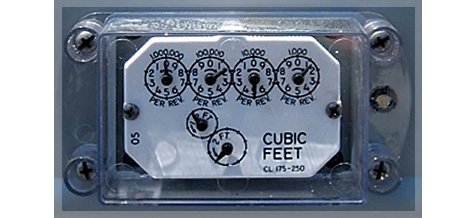Get Tech Tips
Subscribe to free tech tips.
Clocking a Gas Meter (It’s not that hard)

I've heard a lot made of clocking gas meters over the years, and honestly, in Florida, there isn't too much call for heat. There are even fewer furnaces.
I was pleasantly surprised when I found out how easy it actually is. Here is how you do it, step by step:
#1 – Make sure all gas appliances are off other than the one you are clocking. Even shut off pilot lights, or they can mess with your reading.
#2 – Ensure the appliance you are checking is running at high fire (max output).
#3 – Get a stopwatch (your phone has one).
#4 – Watch the smallest unit dial on the gas meter; it will often be 1/2 cubic ft.
#5 – Time how long that dial takes to make one full revolution with the stopwatch.
#6 – Multiply the dial size by 3600 (3600 is the number of seconds in an hr, so if it's a 1/2 cu/ft dial, it would be 1,800.
#7 – Divide that number by the number of seconds it took. So, let's say it took 22 seconds. That would be 1,800 / 22 = 81.82.
#8 – Multiply that number by the BTU heat content of 1 cu/ft of gas provided by the utility. If it is 1,000 (which is common for NG), the total BTU/hr would be 81,820.
The complete formula is cubic feet per hour (CFH) = (3600 x dial size) / time (seconds)
Then, to get the ACTUAL device output in BTUs, you would multiply for the AFUE efficiency. In this case, if it were an 80% furnace, the input is 81,820 BTU/hr, and the output would be 65,456.
Pretty cool, huh?
—Bryan











Comments
Hey Bryan,
I recently started a refrigeration apprenticeship in september. You were one of the people that inspired me to pursue this career path.
I live in Abbotsford BC, Canada and I mainly service high rise residential and small commercial equipment. I am also a journeyman plumber and I have my A ticket in Gas fitting.
I read your blog regarding clocking a gas meter and I thought you might need to add a caveat because your formula will only apply to a 1/2 psi gas meters or lower. In the Vancouver region, were I live, it is common to have 2 psi gas meters on single family homes.
Once you go above a 14″ wc meter pressure you need to apply a pressure correction factor: (actual barometric pressure + meter pressure)÷(standard barometric pressure 14.73 psia)
And a temperature correction factor:
(Actual temperature: 460°F + dry bulb temperature) ÷ (standard temperature: 460°F + 60°F)
If somebody tries to apply your formula to a high pressure gas meter they may wonder why its so under fired.
Anyways, I really appreciate all the podcasts you have been putting out.
Thank you,
David
Hey Bryan,
I recently started a refrigeration apprenticeship in september. You were one of the people that inspired me to pursue this career path.
I live in Abbotsford BC, Canada and I mainly service high rise residential and small commercial equipment. I am also a journeyman plumber and I have my A ticket in Gas fitting.
I read your blog regarding clocking a gas meter and I thought you might need to add a caveat because your formula will only apply to a 1/2 psi gas meters or lower. In the Vancouver region, were I live, it is common to have 2 psi gas meters on single family homes.
Once you go above a 14″ wc meter pressure you need to apply a pressure correction factor: (actual barometric pressure + meter pressure)÷(standard barometric pressure 14.73 psia)
And a temperature correction factor:
(Actual temperature: 460°F + dry bulb temperature) ÷ (standard temperature: 460°F + 60°F)
If somebody tries to apply your formula to a high pressure gas meter they may wonder why its so under fired.
Anyways, I really appreciate all the podcasts you have been putting out.
Thank you,
David
RE: Digital Gas Meters
Anyone have the secret decoder ring for getting this info out of a digital gas meter? 🙂
RE: Digital Gas Meters
Anyone have the secret decoder ring for getting this info out of a digital gas meter? 🙂
To leave a comment, you need to log in.
Log In